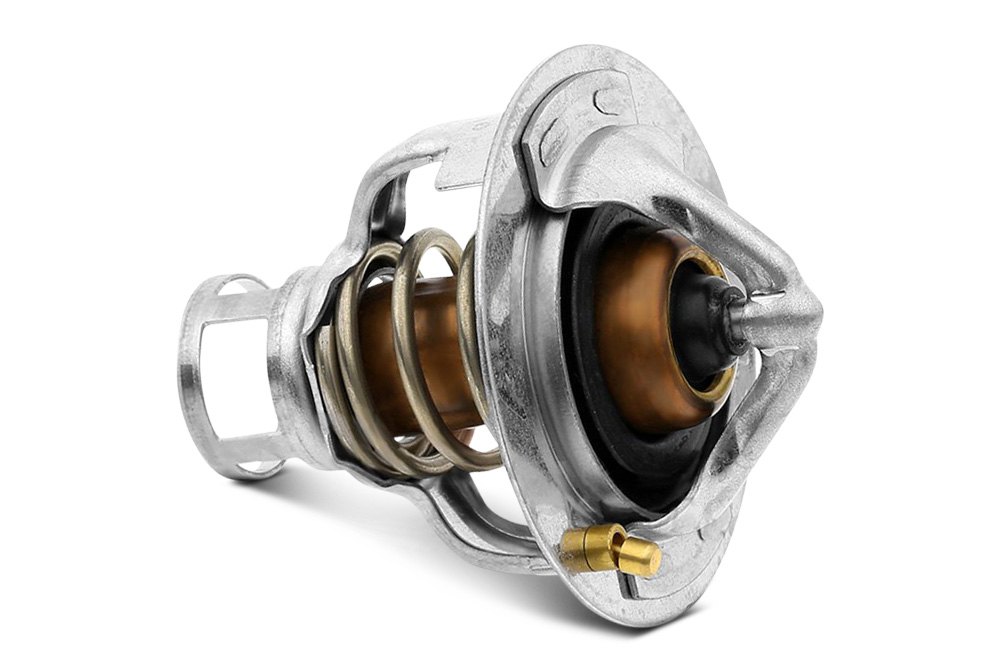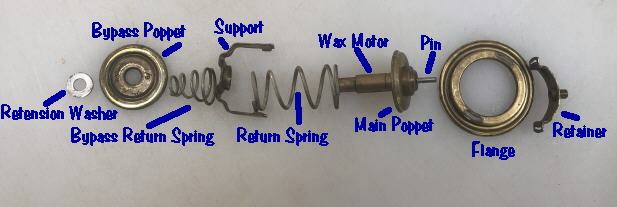Automotive Thermostats


| The
humble automobile thermostat has more complexity than meets the eye. At
it's heart it's a thermal valve which regulates coolant flow by opening
and closing the path to the radiator. But that's just the beginning...
To start this off, let's get the most important point out on the table. The purpose of a thermostat is to get the engine warm fast and keep it warm. There are other parts of the cooling system that actually keep things cool: pumps, fans, and radiators. And I may cover these subsystems in future papers. But the function of a thermostat is to keep things warm. Not too hot, not too cool. Warm. Which begs the question of what is the correct operating temperature? Very early in the development of automobiles, it was recognized that there was a relationship between engine performance and operating temperature. A gasoline engine operates best within a narrow temperature range. This is due to several factors:
What the thermostat isn't intended to accomplish is to keep the engine cool. If the radiator, pump and fan don't have enough capacity, the engine is going to run warm no matter how well the thermostat flows. The thermostat just establishes a lower bound. We'll see in the discussion of bypass systems how these concepts have been refined through the years, but for vintage applications, the thermostat establishes the lower bound of operating temperature, not the upper bound. (The exception, of course, is a malfunctioning thermostat...if the thermostat sticks, the radiator can't do its job at all.) Pictures
are worth a thousand words, so let's look at some graphics. These graphs
come from a GM engineering document that's contemporary with E-Type development,
to demonstrate that none of this is new or controversial information.
The graphs demonstrate that wear DECREASES with increasing temperature.
That fuel economy INCREASES with increasing temperature. And that oil contamination
due to fuel and water condensation DECREASES with increasing temperature.
Again, the objective isn't to run cool, it's to run at the right temperature!
And yet, how many old car owners strive to run at ever-colder temperatures?
Doing the thing that's intuitively pleasing isn't doing the right thing!
 This is a typical thermostat. When the thermostat is open, coolant passes through the hole in the flange. When it's closed, the main poppet seals the opening in the flange. This particular thermostat is a dual poppet thermostat from a balanced flow bypass system (more about this in subsequent chapters.) The second poppet controls the bypass port on the engine, which allows coolant to circulate around the block when it's not sent to the radiator. The following chapters will take you through an explanation of the various parts of a thermostat before plunging into the detail of Jaguar applications. The next two chapters will address the types of thermal motors that allow thermostats to regulate flow: bellows and wax in chapters 2 and 3. By way of introduction, this is a good place to talk about how they work in general.
Wax thermostats began to appear in British iron in the mid 60's. Earlier British cars (including E-Type 3.8's) used bellows thermostats. Both types work on similar principles: an engineered substance is sealed in a metal container. A bellows motor is charged with alcohol or volatile oil, and a wax motor is obviously charged with wax. The substance will either vaporize or melt in the desired temperature range. This is called phase transition, and when it happens the motive substance will expand rapidly. This chemical expansion is harnessed to cause physical movement. Since phase transition is a fixed chemical property, the events of expansion and contraction will occur at predictable temperatures. This is a repeatable event, as long as the thermostat capsule and seals aren't compromised. It's an idea that goes back to the steam age, but that doesn't mean it doesn't work effectively.
The substances used will expand when heated under any conditons, but during phase transition, there will be much more expansion than at any other temperature. The reason this is important is that there is a natural assumption that the opening rate of the thermostat is linear. In fact, the thermostat remains tightly closed under spring tension as temperature rises, until it approaches transition from solid to liquid. Most of the expansion will occur as the wax liquefies or the alcohol boils. When the transition is fully complete, the thermostat may continue open much more slowly. But the bulk of the movement will be done. Phase transition has benefits other than a predictable opening temperature. At phase transition, the material needs to be supercooled (cooled below it's melting point) to solidify in a process called nucleation. As a byproduct, the thermostat has a certain slowness of movement in relation to changing temperature. This property is called hysteresis, a delay in reacting to temperature changes. It's actually desirable. Hysteresis prevents the thermostat from "motorboating", snapping from open to closed, in response to minor temperature fluctuations.
So now
we know that the thermostat's properties are permanently determined by
the materials from which it's made. It will open at a specific temperature,
and it won't react instantly to transient conditions. As a result, it will
tend to settle at an equilibrium position under steady operating conditions.
Copyright Coolcat Express Corp © 2019 |
||||||||||